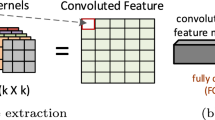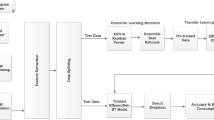Abstract
The Support Vector Machine (SVM) can be used to perform linear and nonlinear operations to solve regression and classification problems. The SVM algorithm is straightforward, generating a line or a hyperplane that can be used for separating different classes of data. However, due to its high computational complexity, SVM is a time-consuming algorithm when modeled solely with software. Various researchers attempted to implement SVM in hardware particularly on field-programmable gate array (FPGA) platforms in order to achieve high performance at lower cost and power consumption. As a result, the algorithm is unsuitable for embedded real-time applications. Therefore, SVM linear classifier is implemented on hardware which decreases the latency and executes the task in real time. In this paper, an SVM linear classifier with pipeline architecture is proposed for fast processing in Verilog HDL using a single-precision IEEE standard 754 number format. In order to perform a study related to hardware resource utilization and timing for the WBCD breast cancer datasets. The various performance metrics such as resource utilization, on-chip power consumption, and static timing analysis with constraints are evaluated. The accuracy rate is computed both using software and hardware for performance evaluation. The pipelined SVM architecture is designed using Verilog HDL, and then it is synthesized using the Vivado simulation tool. The design is configured to the Xilinx KC705 Kintex-7 evaluation board for implementation. This paper mainly focuses on the design of an SVM linear classifier with pipelined architecture for FPGA implementation. The FPGA-based two-class SVM classifier can perform fast data classification due to the advanced parallel calculation feature provided by FPGA. The classification system operates in a linear fashion. The simulation and synthesis results show that the SVM linear classification system can be able to classify data effectively.




















Similar content being viewed by others
Data availability
Data sharing not applicable to this article as no datasets were generated or analyzed during the current study.
Abbreviations
- SISO:
-
Serial in Serial Out.
- SVM:
-
Support Vector Machine
- THS:
-
Total Hold Slack.
- RAM:
-
Random Access Memory
- CNN:
-
Convolutional Neural Network
- WNS:
-
Worst negative slack.
- FPU:
-
Float Point Unit
- TPWS:
-
Total Pulse Width Negative Slack.
- LUT:
-
Look Up Table
- WPWS:
-
Worst pulse width slack.
- DSP:
-
Digital Signal Processing
- CPU:
-
Central Processing Unit
- SDSoC:
-
Software-Defined System-On-Chip.
- WHS:
-
Worst hold slack.
- FIFO:
-
First in First Out
- SoC:
-
System on Chip
- FF:
-
Flip Flop
- TNS:
-
Total negative Slack.
- BRAM:
-
Block RAM
- FPGA:
-
Field Programmable Gate Array
- DMA:
-
Direct Memory Access
References
Adamowicz E, Walczyk K, Bernat T, Danenas P, Garsva G, Stępień P (2002) Support vector machines and their application in credit risk evaluation process
Afifi S, GholamHosseini H, Sinha R (2019) A system on chip for melanoma detection using FPGA-based SVM classifier. Microprocess Microsyst 65:57–68. https://doi.org/10.1016/j.micpro.2018.12.005
Afifi S, GholamHosseini H, Sinha R (2020) Fpga implementations of svm classifiers: a review. SN Comput Sci 1(3):1–17
Amezzane I, Fakhri Y, El Aroussi M, Bakhouya M (2020) Hardware acceleration of svm training for real-time embedded systems: Overview. Recent Adv Math Technol pp 131–139, Springer
Baccarini LMR, Silva VVRE, de Menezes BR, Caminhas WM (2011) SVM practical industrial application for mechanical faults diagnostic. Exp Syst Appl 38(6):6980–6984
Baez A, Fabelo H, Ortega S, Florimbi G, Torti E, Hernandez A, Leporati F, Danese G, Callico GM, Sarmiento R (2019) High-level synthesis of multiclass SVM using code refactoring to classify brain cancer from hyperspectral images. Electron 8(12):1494
Bassoli M, Bianchi V, De Munari I (2019) A Simulink Model-based Design of a Floating-point Pipelined Accumulator with HDL Coder Compatibility for FPGA Implementation. Appl. Electron. Pervading Ind. Environ. Soc. ApplePies 2019. Lect. Notes Electr. Eng. 1–9, in press
Bassoli M, Bianchi V, De Munari I (2020) A model-based design floating-point accumulator. case of study: Fpga implementation of a support vector machine kernel function. Sensors 20(5):1362. https://doi.org/10.3390/s20051362
Batista GC, Oliveira DL, Saotome O, Silva WLS (n.d.) A low-power asynchronous hardware implementation of a novel SVM classifier, with an application in a speech recognition system. Microelectron J
Blaiech, Ahmed Ghazi, Khaled Ben Khalifa, Carlos Valderrama, Marcelo AC Fernandes, Mohamed Hedi Bedoui (2019) A survey and taxonomy of FPGA-based deep learning accelerators. J Syst Archit 98: 331–345
Breast Cancer Wisconsin (Diagnostic) Data Set (n.d.) https://www.kaggle.com/uciml/breast-cancer-wisconsin-data. Accessed 5 Jan 2020
Carmichael Z, Langroudi HF, Khazanov C, Lillie J, Gustafson JL, Kudithipudi D (2019) Deep positron: a deep neural network using the posit number system. In: 2019 Design, Automation & Test in Europe Conference & Exhibition (DATE), pp 1421–146. https://doi.org/10.23919/DATE.2019.8715262
Carmichael Z, Langroudi HF, Khazanov C, Lillie J, Gustafson JL, Kudithipudi D (2019) Performance-Efficiency Trade-off of Low-Precision Numerical Formats in Deep Neural Networks. In: Proceedings of the Conference for Next Generation Arithmetic 2019 [Internet]. New York, NY, USA: Association for Computing Machinery; (CoNGA’19)
Chen W, Pourghasemi HR, Kornejady A, Zhang N (2017) Landslide spatial modeling: introducing new ensembles of ANN, MaxEnt, and SVM machine learning techniques. Geoderma 305:314–327. https://doi.org/10.1016/j.geoderma.2017.06.020
Cortes C, Vapnik V (1995) Support-vector networks. Mach Learn 20(3):273–297
Fiolhais L, Neto H (2018) An efficient exact fused dot product processor in FPGA. In: 2018 28th International Conference on Field Programmable Logic and Applications (FPL), pp 327–3273. https://doi.org/10.1109/FPL.2018.00062
Khan, F, Khan MA, Abbas S, Athar A, Siddiqui SY, Khan AH, Saeed MA, Hussain M (2020) Cloud-based breast cancer prediction empowered with soft computing approaches. J Healthcare Eng 2020. https://doi.org/10.1155/2020/8017496
Kim, S, Rutenbar RA (2019) An area-efficient iterative single-precision floating-point multiplier architecture for FPGA. In Proceedings of the 2019 on Great Lakes Symposium on VLSI, pp 87–92
Lopes FF, Ferreira JC, Fernandes MAC (2019) Parallel implementation on FPGA of support vector machines using stochastic gradient descent. Electronics 8(6):631. https://doi.org/10.3390/electronics8060631
Louca, L, Cook TA, Johnson WH (1996) Implementation of IEEE single precision floating point addition and multiplication on FPGAs. In FCCM, pp 107–116
Mavroforakis ME, Theodoridis S (2006) A geometric approach to support vector machine (SVM) classification. IEEE Trans Neural Netw 17(3):671–682. https://doi.org/10.1109/TNN.2006.873281
Meng W, Dou Y (2021) An optimization algorithm for computer-aided diagnosis of breast Cancer based on support vector machine. Front Bioeng Biotechnol 9:581
Mohammadi M, Krishna A, Nalesh S, Nandy SK (2018) A hardware architecture for radial basis function neural network classifier. IEEE Trans Parallel Distrib Syst 29(3):481–495
Nadikattu RR (2020) A comparative study between simulation of machine learning and extreme learning techniques on breast Cancer diagnosis. Available at SSRN 3615092
Papadonikolakis M, Bouganis C-S (2008) A scalable FPGA architecture for non-linear SVM training. In: 2008 International Conference on Field-Programmable Technology, pp 337–340. https://doi.org/10.1109/FPT.2008.4762412
Papadonikolakis M, Bouganis C-S (2010) A novel FPGA-based SVM classifier. In 2010 International Conference on Field-Programmable Technology, pp 283–286. IEEE
Patil PP, Kotrappa S (2020) A novel approach to detect microcalcification for accurate detection for diagnosis of breast Cancer. in internet of things, smart computing and technology: a roadmap ahead, pp 81–94. Springer, Cham
Pietron M, Wielgosz M, Zurek D, Jamro E, Wiatr K (2013) Comparison of GPU and FPGA implementation of SVM algorithm for fast image segmentation. In: Architecture of Computing Systems--ARCS 2013: 26th International Conference, Prague, Czech Republic, February 19-22, 2013. Proceedings 26, 292–302
Ragab DA, Attallah O, Sharkas M, Ren J, Marshall S (2021) A framework for breast cancer classification using multi-DCNNs. Comput Biol Med 131:104245 Elsevier
Selvathi D, Nayagam D (2016) FPGA implementation of on-chip ANN for breast cancer diagnosis. Intell Decis Technol 10:1–12. https://doi.org/10.3233/IDT-160261
Selvathi D, Nayagam RD (2016) FPGA implementation of on-chip ANN for breast cancer diagnosis. Intell Decis Technol 10(4):341–352
Siddiqui F, Amiri S, Minhas UI, Deng T, Woods R, Rafferty K, Crookes D (2019) Fpga-based processor acceleration for image processing applications. J Imaging 5(1):16
Subasi A (2020) Practical machine learning for data analysis using Python. Academic Press
Wang C, Gong L, Yu Q, Li X, Xie Y, Zhou X (2016) DLAU: a scalable deep learning accelerator unit on FPGA. IEEE Trans Comput Aided Des Integr Circ Syst 36(3):513–517
Yao Y, Yang L, Yu Y, Xu H, Lv W, Li Z, Chen X (2013) K-SVM: an effective SVM algorithm based on K-means clustering. J Comput 8(10):2632–2639
Yue S, Li P, Hao P (2003) SVM classification: its contents and challenges. Appl Math A J Chin Univ 18:332–342
Author information
Authors and Affiliations
Corresponding author
Ethics declarations
Conflict of interest
All authors certify that they have no affiliations with or involvement in any organization or entity with any financial interest or non-financial interest in the subject matter or materials discussed in this manuscript. The authors have no financial or proprietary interests in any material discussed in this article.
Additional information
Publisher’s note
Springer Nature remains neutral with regard to jurisdictional claims in published maps and institutional affiliations.
Rights and permissions
Springer Nature or its licensor (e.g. a society or other partner) holds exclusive rights to this article under a publishing agreement with the author(s) or other rightsholder(s); author self-archiving of the accepted manuscript version of this article is solely governed by the terms of such publishing agreement and applicable law.
About this article
Cite this article
Laxmisagar, H.S., Hanumantharaju, M.C. FPGA implementation of breast cancer detection using SVM linear classifier. Multimed Tools Appl 82, 41105–41128 (2023). https://doi.org/10.1007/s11042-023-15121-6
Received:
Revised:
Accepted:
Published:
Issue Date:
DOI: https://doi.org/10.1007/s11042-023-15121-6




